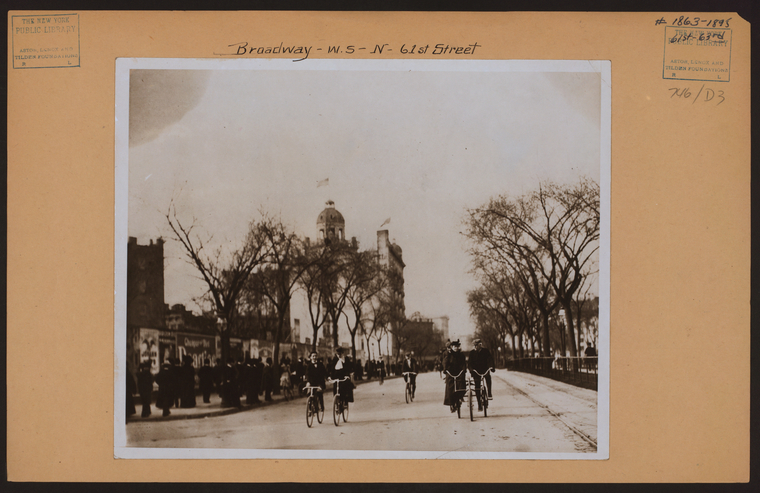Velocipede Mania!

Way back in 1868, New Yorkers were swept up in a craze over the fore-runner to the modern bicycle, the velocipede. Developed in France, the two-wheeled velocipede made its way across the Atlantic to the United States in the 1860s and was taken up by middle-class New Yorkers as a novelty. However, within a few years a full-fledged velocipede-mania developed, eventually dying down in the early 1870s. In 1868 and 1869 alone, nearly a dozen riding schools and tracks opened up across Manhattan and Brooklyn and a number of velocipede manufacturers set up shop in the city as well, fueled by the high demand for more and better versions of the velocipede. Newspapers and periodicals of the day were constantly commenting upon the craze and the effect it had on city life, particularly in the streets and parks. The consequences of the introduction of the velocipede in New York City were many, ranging from discussion of the need for new laws to regulate traffic to debate over the propriety of women riding velocipedes. There is a nice little article from the New York Times describing the intensity of excitement over the velocipede (PDF version).
The New York Public Library, of course, has tons of material on the history and development of the bicycle. There are books on the velocipede as it was in the mid-nineteenth century such as, The Velocipede: Its Past, Present and Future, published in 1869, as well as more recent takes on the history of the bicycle like Herlihy’s Bicycle: the History. However, as I enjoy reading contemporary accounts of events I went to our historical newspaper and periodical databases to get some first hand takes on the mania that swept New York and the rest of the country. A good database to start with is the ProQuest Historical Database which provides access to historical runs of major U.S. newspaper and over a 1,000 periodicals. But there are many more electronic resources available, like Harper’s Weekly and America’s Historical Newspapers, both of which provide tons of material on 19th century America.
Another source to keep in mind, especially when researching a machine such as the velocipede, which was constantly being improved upon, is Google’s Patents Search. While periodicals in the 19th century, such as Scientific American, frequently updated readers on new patents and other technological advancements they don’t show readers the patent in all of its glory. My favorite thus far is the Land & Water Velocipede of 1869; but really any patent search for “Improved Velocipede” yields testimony to the endless inventiveness of Americans. Happy Bike Month!
Read E-Books with SimplyE
 With your library card, it's easier than ever to choose from more than 300,000 e-books on SimplyE, The New York Public Library's free e-reader app. Gain access to digital resources for all ages, including e-books, audiobooks, databases, and more.
With your library card, it's easier than ever to choose from more than 300,000 e-books on SimplyE, The New York Public Library's free e-reader app. Gain access to digital resources for all ages, including e-books, audiobooks, databases, and more.
If you don’t have an NYPL library card, New York State residents can apply for a digital card online or through SimplyE (available on the App Store or Google Play).
Need more help? Read our guide to using SimplyE.
Comments
Bicycle history lecture 5/24/08
Submitted by Anonymous (not verified) on May 1, 2008 - 9:10am
Yeah Bikes!
Submitted by Cynthia Chaldekas on May 1, 2008 - 2:12pm
Post more often
Submitted by Greg (not verified) on July 22, 2008 - 4:42pm